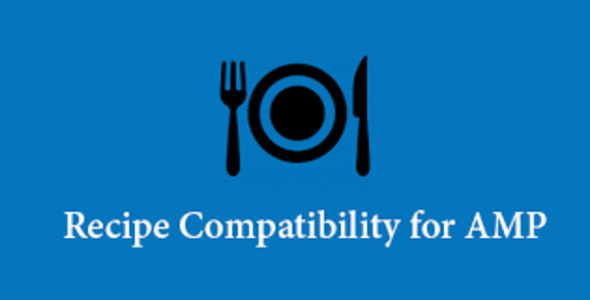Recipe Compatibility for AMP 1.0.3

70+ Reviews
with 5 star Ratings

99% Customer
Satisfaction

7-Days
Money Back
Request update for this product.
$39.00 Original price was: $39.00.$2.99Current price is: $2.99.
- Version: 1.0.3
- Last Updated: 26/12/2024
- License: GPL
- 1 year of updates & unlimited domain usage
- Updates Will Come With A 24-48h Delay
- Original product with the lowest price ever
- Downloaded from original authors
- Instant delivery & fast downloading speed
- 100% clean and tested code
- Get this Product for Free in Membership
As mobile traffic continues to dominate the internet, optimizing websites for speed and performance has never been more critical. For recipe blogs and food-related websites, ensuring fast load times and a seamless mobile experience is paramount. This is where AMP (Accelerated Mobile Pages) comes in. AMP is a technology developed by Google to create lightweight, fast-loading web pages that enhance the mobile browsing experience. In this article, we’ll explore how recipe websites can improve their mobile compatibility with AMP and ensure their recipes are optimized for both speed and user experience.
What is AMP?
AMP stands for Accelerated Mobile Pages, a project initiated by Google aimed at making web pages load faster on mobile devices. AMP pages are stripped-down versions of regular web pages, with a focus on performance and minimalism. AMP uses a specific HTML framework and is designed to ensure that pages load instantly, even on slow mobile networks. As part of the AMP project, Google introduced a set of guidelines for creating AMP-compliant pages, which includes the AMP HTML format, AMP JS, and AMP Cache.
For food bloggers and recipe websites, AMP presents an opportunity to improve page speed, increase search engine visibility, and provide a better mobile experience for users.
Why AMP is Important for Recipe Websites
- Improved Mobile Experience: The majority of recipe searches occur on mobile devices. When a recipe website is AMP-compatible, it ensures that users experience fast-loading, easy-to-navigate pages, increasing the likelihood of engagement and conversions (such as social shares, email subscriptions, or purchases).
- SEO Benefits: Google gives preference to AMP pages in its search rankings. Pages that load quickly and are mobile-friendly are ranked higher, improving the visibility of your recipe content. Additionally, AMP can help boost your website’s core web vitals, which is essential for SEO performance.
- Faster Load Times: Slow loading times are one of the primary reasons visitors leave a website. AMP pages are optimized for speed, helping reduce bounce rates and keep users engaged with your content.
- Higher User Retention: Since AMP ensures a seamless mobile experience, users are more likely to stay on your website and explore more recipes. With faster load times and streamlined content, visitors can quickly find and follow recipes without frustration.
Best Practices for Recipe Compatibility with AMP
To make your recipe website AMP-compatible, here are some essential best practices to follow:
1. Using AMP HTML for Recipes
AMP pages use a specialized HTML framework to ensure that web pages load quickly. The basic structure of an AMP page is quite similar to regular HTML but with some essential differences. Key tags in AMP HTML include:
<amp-img>: AMP requires images to be loaded using this tag, which provides faster image loading times by automatically optimizing image delivery.<amp-video>: If you include videos in your recipe posts, use the<amp-video>tag to ensure videos load quickly and do not affect page speed.<amp-carousel>: This tag allows for carousels, a great way to showcase images of your recipe steps or finished dishes.
Using these AMP HTML tags will ensure that your recipe website is compliant with AMP standards and performs optimally.
2. Recipe Schema Markup
To make your recipe content more discoverable by search engines, implementing structured data with schema markup is essential. Google can use schema markup to display rich results, such as recipe cards with ratings, ingredients, cooking time, and more. When creating AMP pages for recipes, ensure that your structured data is valid and correctly implemented.
Recipe schema markup typically includes elements like:
recipeIngredient: A list of ingredients for the recipe.recipeInstructions: The step-by-step cooking instructions.cookTimeandprepTime: Cooking and preparation times for the recipe.recipeYield: The number of servings the recipe produces.image: A photo of the finished dish.
Adding this structured data not only helps improve SEO but also makes your recipes stand out in search results with rich snippets.
3. Optimize Images for AMP
Images play a crucial role in recipe content. High-quality images of the dish, ingredients, and cooking process can engage users and encourage them to try the recipe. However, large image files can significantly slow down your page load time, especially on mobile devices.
With AMP, you must use the <amp-img> tag instead of the standard <img> tag. The <amp-img> tag automatically optimizes images for better performance. Here are some tips for image optimization on AMP pages:
- Compress Images: Use image compression tools to reduce file sizes without sacrificing quality. This ensures faster loading times.
- Responsive Images: Make sure your images adjust to different screen sizes. AMP’s
<amp-img>tag allows you to specify sizes for images, which ensures they look great on mobile devices. - Lazy Loading: Use lazy loading to load images only when they are in the user’s viewport. This reduces the amount of data that needs to be loaded when a user first accesses the page.
4. Use AMP Components for Recipe Functionality
AMP provides various components designed to improve the functionality of your recipe pages while maintaining performance. Some useful components for recipe websites include:
- AMP Forms: If you have a recipe submission form or a subscription form, use AMP forms to ensure they load quickly and work efficiently.
- AMP Lightbox: This component allows you to display images in a fullscreen view when clicked, creating a more interactive and engaging experience for users without affecting load times.
- AMP List: If you have a collection of recipes, using AMP List can help load your recipe posts more efficiently, providing a better user experience.
5. AMP-Friendly Recipe Layouts
While maintaining the focus on speed and performance, it’s also crucial to keep your recipe layouts user-friendly and visually appealing. AMP may require adjustments to your traditional recipe page layouts, but here are some tips to maintain a great user experience:
- Minimalist Design: Keep the design simple and clean. Avoid heavy use of third-party scripts, excessive ads, or pop-ups, which can slow down page load times.
- Recipe Cards: Use AMP-compatible recipe card plugins or custom code to display your recipes in a structured, easy-to-follow format. Recipe cards with clear headers for ingredients, instructions, and cooking time can make it easier for users to follow your recipes.
- Clear Call to Actions: Make it easy for users to share your recipes or save them for later. Integrate AMP-compatible social sharing buttons and recipe bookmarking features.
6. Testing and Validation
Before publishing your AMP pages, it’s crucial to test them to ensure they comply with AMP guidelines. Use Google’s AMP Validator to check if your pages meet the AMP requirements. If any errors are found, the validator will highlight them so you can make necessary adjustments.
Additionally, Google’s Search Console offers an AMP report that shows how your AMP pages are performing in search results. It’s important to monitor this regularly and address any issues to keep your AMP pages fully optimized.
Conclusion
Recipe compatibility for AMP is a critical factor in ensuring that your recipe website performs well on mobile devices. By using AMP’s HTML framework, schema markup, and image optimization techniques, you can significantly improve page load speeds and provide a better user experience for your audience. AMP also offers SEO benefits, helping your recipes stand out in search engine results and attract more visitors. By following the best practices outlined in this guide, you can ensure your recipe website is AMP-compatible and delivers fast, engaging content that keeps users coming back for more.
You must be logged in to post a review.




Reviews
Clear filtersThere are no reviews yet.